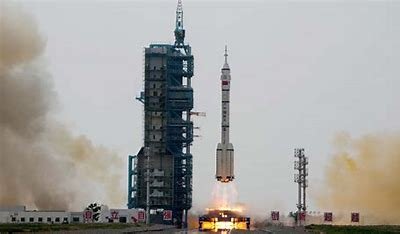China achieved a major milestone in its space exploration endeavors as it successfully launched the Shenzhou-16 manned spaceship on Tuesday. The spacecraft, carrying three astronauts, including the first civilian participant, embarked on a historic journey to China’s space station combination for a five-month mission.
At precisely 9:31 AM Beijing Time, the Shenzhou-16 spacecraft, mounted atop a Long March-2F carrier rocket, blasted off from the Jiuquan Satellite Launch Centre in northwest China. Approximately ten minutes after the launch, Shenzhou-16 separated from the rocket and entered its designated orbit. The China Manned Space Agency (CMSA) confirmed that the crew members were in good shape, and the launch was a resounding success.
The primary objective of the mission is for the astronauts to dock with the Tianhe core module of China’s space station, located approximately 400km above the Earth’s surface. This will be accomplished within a remarkably short time frame of less than seven hours. Notably, China broke new ground by including a civilian, Gui Haichao, a payload specialist and professor at Beihang University in Beijing, in its rotating crew for the space station. Gui’s inclusion marks a departure from the station’s previous reliance on military personnel.
Joining Gui on this historic journey are mission commander Jing Haipeng, who sets a record as the first Chinese astronaut to venture into space for a remarkable fourth time, and astronaut flight engineer Zhu Yangzhu, making his maiden voyage into space.
The Shenzhou-16 mission represents a significant milestone for China’s space station program, as it transitions from development to application. Lin Xiqiang, deputy director of CMSA, emphasized that the crew members would remain in orbit for approximately five months, during which they will conduct a series of large-scale tests and experiments in various fields.
China’s space station, once operational, will set it apart as the sole country with such an asset, as the International Space Station (ISS) is a collaborative effort involving multiple nations and is scheduled to be decommissioned by 2030.
One notable feature of China’s space station is its two robotic arms, with the longer arm possessing the capability to retrieve objects, including satellites, from space. Following its successful launch, the Shenzhou-16 spacecraft will swiftly rendezvous and dock with the space station combination through an automated process.
The astronauts on board the Shenzhou-16 are expected to make substantial scientific advancements during their mission. The areas of focus include the study of novel quantum phenomena, high-precision space-time-frequency systems, the verification of general relativity, and the origin of life.
With the launch of Shenzhou-16, the Long March carrier rocket series achieves its 475th flight mission, further exemplifying China’s dedication to space exploration and technological advancement.
As China forges ahead in its space exploration journey, this successful launch and the inclusion of a civilian astronaut mark significant milestones, setting the stage for further advancements in space science and technology.

